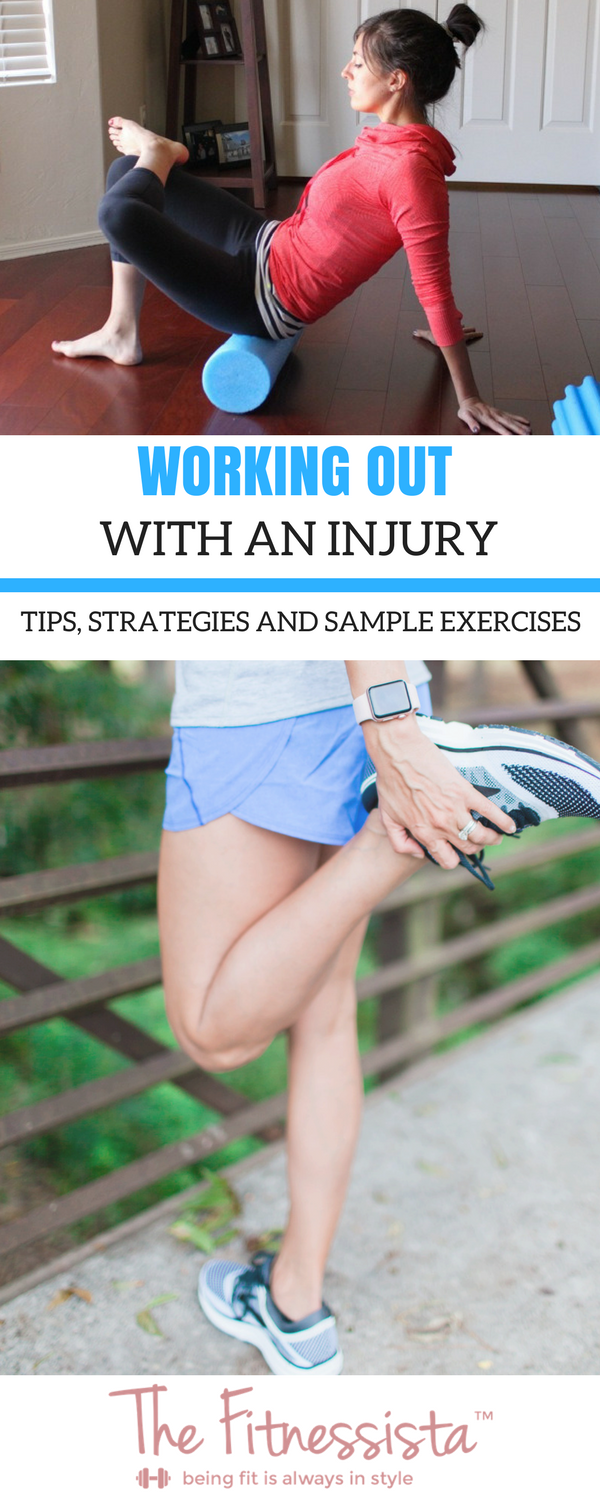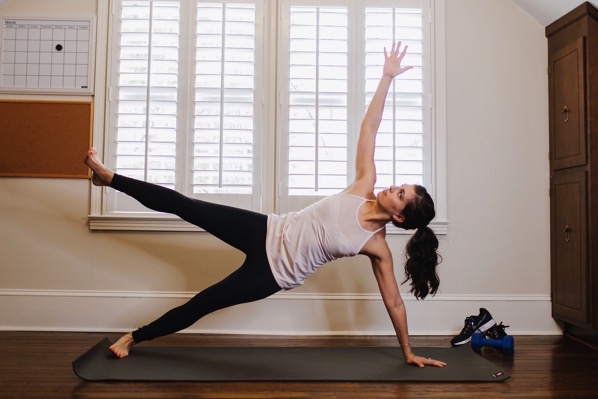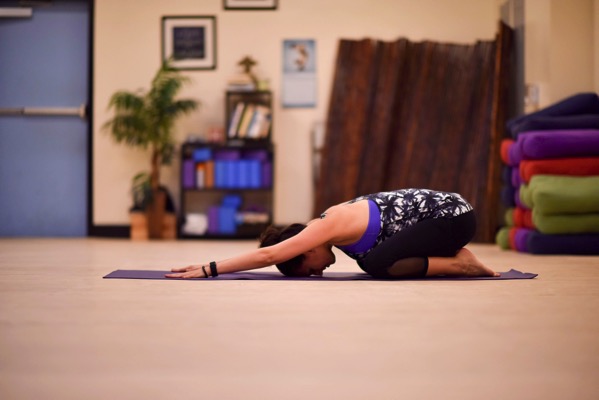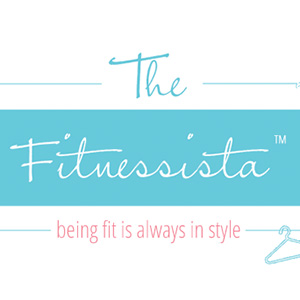Working out with an injury
Over the years of blogging, I’ve received a lot of requests about this particular topic. Can I work out with an injury? What exercises are good for a knee injury? What exercises are good after shoulder surgery? How can I keep working out even though an injury has me sidelined?
I want to start off this post by stating the obvious here: I am NOT a doctor. The person who will give you the best guidelines for your particular situation is your own physician. Also, I’m not a physical therapist. If you have any type of injury or are recovering from surgery, I highly, highly recommend seeing a qualified PT in your area. They’re a wealth of knowledge and can help support you + give you the tools you need on your healing journey.
Tips for Working Out with an Injury
Here’s what I’ve learned in my own experience regarding workouts with injuries and recovering from surgery:
-Rest is best. If something is bothering you and you’re instructed to stay off it, LISTEN. I know it can be really tempting to try things out if you’re feeling good on a particular day, but it’s so not worth risking further damage. It can be a giant pain to sit still and let things heal, but in the grand scheme of things, it’s such a small amount of time. When I was recovering from my knee injury in Tucson, I wanted to run SO BADLY…but I knew that if I did, I’d be risking injuring my knee further and possibly dealing with other issues down the line.
It’s not so much “Can I work out?” as “Should I work out?”
(After my surgery last year, I couldn’t imagine being able to side plank again. And here we are! Wahoo!)
-For upper body injuries, you can often do cardio, core and lower body workouts if your doctor says it’s ok. When I was recovering from my hand surgery, I still did lower body workouts, cardio and spin with no problems. I relied on machines instead of loading or carrying any weight myself, as well as bodyweight workouts. For spin class, I stayed in the saddle more often and avoided putting any weight on my hand. Walking and treadmill sprints were totally fine. Upper body strength training and yoga were out.
-For lower body injuries, you can generally still work your upper body in a seated position. It can feel good to do overhead presses, overhead triceps extensions, biceps curls, upright rows, and incline chest presses in a seated position. You could also use one of those cranking machines at the gym to get your heart rate up. For lower body injuries, most traditional cardio options (including swimming) can be off-limits for a while. Remember that rest is best, and that you can always get back into it when you’re fully healed. I find that when I’m in a situation where I can’t work out as I’d like (or have to skip cardio for recovery), I use that as an opportunity to really focus on solid nutrition.
-For back injuries, mat Pilates can be a great option if your doctor approves. The abdominal exercises can feel supportive, and you can still get in a total body workout without needing to get up and down a lot. (Skip any prone exercises focusing on the back muscles.) In this case, it obviously depends on the severity of the situation. I threw my back out in Zumba last year (the Pilot said if I was really injured, I needed to invent a better story haha), and couldn’t do ANYTHING that day. I laid in the bathtub moaning for like an hour. So remember: rest is best. (I’m going to say that a thousand times, mmm k?)
-Some exercises that can be generally beneficial during injury recovery, if you modify as needed: restorative yoga, Pilates, walking, and swimming. When I had a knee injury in Tucson, I used the water treadmill at the resort and it was a great way to get in some cardio with minimal impact on my joints.
–Physical therapists can provide valuable insight and tools for your unique situation. Oftentimes, injuries aren’t the result of a single incident or moment in time. They’re the slow build of altered movement patterns, compensation and muscle imbalances. Then something will happen (like my Zumba incident) that’s literally the straw that broke the dancing camel’s back.
A physical therapist can help you assess your weak areas, which contribute to imbalances and altered movement patterns. You’ll get small, controlled exercises that you can do at home, and tips for posture and alignment. I love the idea of focusing on pre-hab instead of re-hab; training your body effectively with proper form, solid recovery, sleep and nutrition to keep it running at its optimal level.
So, tell me friends: have you ever had an injury or had to recover from surgery? What exercises felt good and what did you avoid?
I’m interested to hear your stories. <3
Have a happy Wednesday and I’ll see ya soon!
xo
Gina



















Thank you for this post!! I recently broke my ankle, but I found a trainer named Caroline Jordan on youtube who does foot/ankle injury workouts. I’m so glad I found a way to still workout!
ohhh that’s awesome! i love caroline’s workouts
I can’t do any lower body workouts right now because of my current “leg situation” I like to call it 😉 which really make me miss booty workouts BUT I get to focus on my upper body and nutrition! Ps. where are those blue shorts from?!
i hope that your leg is healed for you soon! they’re from brooks 🙂
Yes, a lot of times rest is best! So frustrating when you really want to get in a good sweat. I had 2 abdominal surgeries back to back a few years ago and I was really limited in what I could do for a while. I rested and healed and mostly walked. Even light weights was too much. I just walked until I could ease back into running. I listened to my body and I was grateful for full recovery. The hardest part for me was paying attention to how I was eating because I started to crave junk!
abdominal surgeries are their own special kind of beast. you really can’t do anything except walk (maybe) and a rest a lot. smart that you listened to your body and took it easy!
I get this question a lot too from readers probably because I went through a cycle of injuries for years that just would not stop until I went gluten free, but that’s another story. I think sometimes people don’t want to DEAL with the reality of being injured so they ask this question because they want to control the situation. Like you said, it’s not a question if you can but if you should workout.
same! i feel like i had a knee injury often until i changed my training and my diet
I had really bad SI Joint pain late last year and early this year. My doctor told me to rest and stretch and avoid any heavy lifting. It sucked so bad but once I listed and focused on core work, my back started feeling better! With time and lots of reformer Pilates, I can say that my back pain is gone! I’m back to heavy lifting but I made sure to slowly scale it up and still take plenty of time to rest and listen to my body.
that’s so good that it healed. so smart of you to take your time and recover slowly <3
I struggled with ball-of-the-foot stress fractures and found that I could still do standing strength work, just no jumping, flexion of the foot, etc. But yes, REST is best. Great post, Gina! 🙂
I have had some foot issues, so no running, but swimming was a god send to keep me busy, and weight training was ok for the most part. The worst injury is tearing/straining of the intercostal muscles. I have done it twice now (different sides), and its amazing how little you can do without aggravating them. And they take so long to heal. Its an exercise in patience and trying to keep your sanity that goes on for 6-8 weeks. Not fun!
I pretty much suffered from one pain or another for the first couple of years of running. Overtraining, improper shoes, etc. Even after I corrected those problems the pain didn’t really go away until I started strength training. A gym is a runners best friend!
oh man. that sounds so rough! have you seen a PT? i feel like they always have great tips